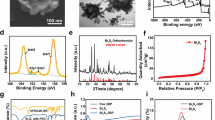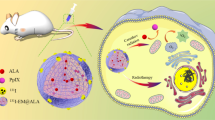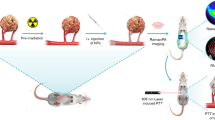Abstract
More than 60% of cancer patients receive radiation therapy (RT) during their anticancer treatment. However, there is a huge challenge to improve the therapeutic efficacy of RT in less radioresponsive tumors and decrease damages dealt to the surrounding healthy tissues. Herein, we have reported the development of an efficacious RT treatment of relatively radioresistant breast cancer using W18O49 nanospheres and the second near-infrared (NIR) light irradiation. Featuring the X-ray attenuation ability and photothermal effect, together with ability to generate intracellular singlet oxygen and ·OH, W18O49 nanospheres can significantly increase radiation-induced DNA damage and decrease the mitochondrial membrane potential of cancer cells during RT, causing in nearby three-times improvement in inhibiting the proliferation of 4T1 cells. The in vivo evaluations verify that a rather effective therapeutic outcome is achieved by treatment of 4T1 tumor xenograft with NIR-enhanced RT using W18O49 nanospheres. Moreover, the X-ray attenuation ability and the strong near-infrared absorption of W18O49 nanospheres have enabled highly resolved in vivo computer tomography (CT)/photoacoustic (PA) imaging. This work presents an “all-in-one” synergistic platform to improve the therapeutic efficacy of RT in less radioresponsive tumors, therefore opening a new door for multimodal cancer therapy.

Similar content being viewed by others
References
Gluz, O.; Liedtke, C.; Gottschalk, N.; Pusztai, L.; Nitz, U.; Harbeck, N. Triple-negative breast cancer —current status and future directions. Ann. Oncol. 2009, 20, 1913–1927.
Bai, X. P.; Ni, J.; Beretov, J.; Graham, P.; Li, Y. Triple-negative breast cancer therapeutic resistance: Where is the Achilles’ heel? Cancer Lett. 2021, 497, 100–111.
Formenti, S. C.; Demaria, S. Systemic effects of local radiotherapy. Lancet Oncol. 2009, 10, 718–726.
Song, G. S.; Cheng, L.; Chao, Y.; Yang, K.; Liu, Z. Emerging nanotechnology and advanced materials for cancer radiation therapy. Adv. Mater. 2017, 29, 1700996.
The Cancer Genome Atlas Network. Comprehensive molecular portraits of human breast tumours. Nature 2012, 490, 61–70.
He, M. Y.; Rancoule, C.; Rehailia-Blanchard, A.; Espenel, S.; Trone, J. C.; Bernichon, E.; Guillaume, E.; Vallard, A.; Magné, N. Radiotherapy in triple-negative breast cancer: Current situation and upcoming strategies. Critical Rev. Oncol./Hematol. 2018, 131, 96–101.
Schmid, P.; Adams, S.; Rugo, H. S.; Schneeweiss, A.; Barrios, C. H.; Iwata, H.; Diéras, V.; Hegg, R.; Im, S. A.; Wright, G. S. et al. Atezolizumab and nab-paclitaxel in advanced triple-negative breast cancer. N. Engl. J. Med. 2018, 379, 2108–2121.
Mi, Y.; Shao, Z. Y.; Vang, J.; Kaidar-Person, O.; Wang, A. Z. Application of nanotechnology to cancer radiotherapy. Cancer Nanotechnol. 2016, 7, 11.
Du, J. F.; Gu, Z. J.; Yan, L.; Yong, Y.; Yi, X.; Zhang, X.; Liu, J.; Wu, R. F.; Ge, C. C.; Chen, C. Y. et al. Poly(vinylpyrollidone)- and selenocysteine-modified Bi2Se3 nanoparticles enhance radiotherapy efficacy in tumors and promote radioprotection in normal tissues. Adv. Mater. 2017, 29, 1701268.
Kwatra, D.; Venugopal, A.; Anant, S. Nanoparticles in radiation therapy: A summary of various approaches to enhance radiosensitization in cancer. Transl. Cancer Res. 2013, 2, 330–342.
Carter, J. D.; Cheng, N. N.; Qu, Y. Q.; Suarez, G. D.; Guo, T. Nanoscale energy deposition by X-ray absorbing nanostructures. J. Phys. Chem. B 2007, 111, 11622–11625.
Wang, S. F.; Liu, J. L.; Qiu, S. F.; Yu, J. M. Facile fabrication of Cu9-S5 loaded core-shell nanoparticles for near infrared radiation mediated tumor therapeutic strategy in human esophageal squamous carcinoma cells nursing care of esophageal cancer patients. J. Photochem. Photobiol. B 2019, 199, 111583.
Gao, S. Q.; Li, T. Y.; Guo, Y.; Sun, C. X.; **anyu, B. R.; Xu, H. P. Selenium-containing nanoparticles combine the NK cells mediated immunotherapy with radiotherapy and chemotherapy. Adv. Mater. 2020, 32, 1907568.
Wang, L. Y.; Zhang, T. T.; Huo, M. F.; Guo, J.; Chen, Y.; Xu, H. X. Construction of nucleus-targeting iridium nanocrystals for photonic hyperthermia-synergized cancer radiotherapy. Small 2019, 15, e1903254.
Song, G. S.; Chao, Y.; Chen, Y. Y.; Liang, C.; Yi, X.; Yang, G. B.; Yang, K.; Cheng, L.; Zhang, Q.; Liu, Z. All-in-one theranostic nanoplatform based on hollow TaOx for chelator-free labeling imaging, drug delivery, and synergistically enhanced radiotherapy. Adv. Funct. Mater. 2016, 26, 8243–8254.
Song, G. S.; Chen, Y. Y.; Liang, C.; Yi, X.; Liu, J. J.; Sun, X. Q.; Shen, S. D.; Yang, K.; Liu, Z. Catalase-loaded TaOx nanoshells as bio-nanoreactors combining high-Z element and enzyme delivery for enhancing radiotherapy. Adv. Mater. 2016, 28, 7143–7148.
Atkinson, R. L.; Zhang, M.; Diagaradjane, P.; Peddibhotla, S.; Contreras, A.; Hilsenbeck, S. G.; Woodward, W. A.; Krishnan, S.; Chang, J. C.; Rosen, J. M. Thermal enhancement with optically activated gold nanoshells sensitizes breast cancer stem cells to radiation therapy. Sci. Transl. Med. 2010, 2, 55ra79.
Yang, Y. S.; Carney, R. P.; Stellacci, F.; Irvine, D. J. Enhancing radiotherapy by lipid nanocapsule-mediated delivery of amphiphilic gold nanoparticles to intracellular membranes. ACS Nano 2014, 8, 8992–9002.
Bonvalot, S.; Rutkowski, P. L.; Thariat, J.; Carrère, S.; Ducassou, A.; Sunyach, M. P.; Agoston, P.; Hong, A.; Mervoyer, A.; Rastrelli, M. et al. NBTXR3, a first-in-class radioenhancer hafnium oxide nanoparticle, plus radiotherapy versus radiotherapy alone in patients with locally advanced soft-tissue sarcoma (Act. In. Sarc): A multicentre, phase 2–3, randomised, controlled trial. Lancet Oncol. 2019, 20, 1148–1159.
Maggiorella, L.; Barouch, G.; Devaux, C.; Pottier, A.; Deutsch, E.; Bourhis, J.; Borghi, E.; Levy, L. Nanoscale radiotherapy with hafnium oxide nanoparticles. Future Oncol. 2012, 8, 1167–1181.
Bonvalot, S.; Le Pechoux, C.; De Baere, T.; Kantor, G.; Buy, X.; Stoeckle, E.; Terrier, P.; Sargos, P.; Coindre, J. M.; Lassau, N. et al. First-in-human study testing a new radioenhancer using nanoparticles (NBTXR3) activated by radiation therapy in patients with locally advanced soft tissue sarcomas. Clin. Cancer Res. 2017, 27, 908–917.
Chen, Q.; Chen, J. W.; Yang, Z. J.; Xu, J.; Xu, L. G.; Liang, C.; Han, X.; Liu, Z. Nanoparticle-enhanced radiotherapy to trigger robust cancer immunotherapy. Adv. Mater. 2019, 31, 1802228.
Huo, D.; Liu, S.; Zhang, C.; He, J.; Zhou, Z. Y.; Zhang, H.; Hu, Y. Hypoxia-targeting, tumor microenvironment responsive nanocluster bomb for radical-enhanced radiotherapy. ACS Nano 2017, 11, 10159–10174.
Carlisi, D.; De Blasio, A.; Drago-Ferrante, R.; Di Fiore, R.; Buttitta, G.; Morreale, M.; Scerri, C.; Vento, R.; Tesoriere, G. Parthenolide prevents resistance of MDA-MB231 cells to doxorubicin and mitoxantrone: The role of Nrf2. Cell Death Discov. 2017, 3, 17078.
Yong, Y.; Cheng, X. J.; Bao, T.; Zu, M.; Yan, L.; Yin, W. Y.; Ge, C. C.; Wang, D. L.; Gu, Z. J.; Zhao, Y. L. Tungsten sulfide quantum dots as multifunctional nanotheranostics for in vivo dual-modal image-guided photothermal/radiotherapy synergistic therapy. ACS Nano 2015, 9, 12451–12463.
Park, Y. S.; Liz-Marzán, L. M.; Kasuya, A.; Kobayashi, Y.; Nagao, D.; Konno, M.; Mamykin, S.; Dmytruk, A.; Takeda, M.; Ohuchi, N. X-ray absorption of gold nanoparticles with thin silica shell. J. Nanosci. Nanotechnol. 2006, 6, 3503–3506.
Qiu, J. J.; **ao, Q. F.; Zheng, X. P.; Zhang, L. B.; **ng, H. Y.; Ni, D. L.; Liu, Y. Y.; Zhang, S. J.; Ren, Q. G.; Hua, Y. Q. et al. Single W18O49 nanowires: A multifunctional nanoplatform for computed tomography imaging and photothermal/photodynamic/radiation synergistic cancer therapy. Nano Res. 2015, 8, 3580–3590.
Chen, Z. G.; Wang, Q.; Wang, H. L.; Zhang, L. S.; Song, G. S.; Song, L. L.; Hu, J. Q.; Wang, H. Z.; Liu, J. S.; Zhu, M. F. et al. Ultrathin PEGylated W18O49 nanowires as a new 980 nm-laser-driven photothermal agent for efficient ablation of cancer cells in vivo. Adv. Mater. 2013, 25, 2095–2100.
Kalluru, P.; Vankayala, R.; Chiang, C. S.; Hwang, K. C. Photosensitization of singlet oxygen and in vivo photodynamic therapeutic effects mediated by PEGylated W18O49 nanowires. Angew. Chem., Int. Ed. 2013, 52, 12332–12336.
Zhou, Z. G.; Kong, B.; Yu, C.; Shi, X. Y.; Wang, M. W.; Liu, W.; Sun, Y. N.; Zhang, Y. J.; Yang, H.; Yang, S. P. Tungsten oxide nanorods: An efficient nanoplatform for tumor CT imaging and photothermal therapy. Sci. Rep. 2014, 4, 3653.
Guo, W.; Guo, C. S.; Zheng, N. N.; Sun, T. D.; Liu, S. Q. CsxWO3 nanorods coated with polyelectrolyte multilayers as a multifunctional nanomaterial for bimodal imaging-guided photothermal/photodynamic cancer treatment. Adv. Mater. 2017, 29, 1604157.
Peng, H. P.; Liu, P.; Lin, D. W.; Deng, Y. N.; Lei, Y.; Chen, W.; Chen, Y. Z.; Lin, X. H.; **a, X. H.; Liu, A. L. Fabrication and multifunctional properties of ultrasmall water-soluble tungsten oxide quantum dots. Chem. Commun. 2016, 52, 9534–9537.
Deng, K. R.; Hou, Z. Y.; Deng, X. R.; Yang, P. P.; Li, C. X.; Lin, J. Enhanced antitumor efficacy by 808 nm laser-induced synergistic photothermal and photodynamic therapy based on a indocyanine-green-attached W18O49 nanostructure. Adv. Funct. Mater. 2015, 25, 7280–7290.
Sordillo, L. A.; Pu, Y.; Pratavieira, S.; Budansky, Y.; Alfano, R. R. Deep optical imaging of tissue using the second and third near-infrared spectral windows. J. Biomed. Opt. 2014, 19, 056004.
Liu, Y.; Zhen, W. Y.; **, L. H.; Zhang, S. T.; Sun, G. Y.; Zhang, T. Q.; Xu, X.; Song, S. Y.; Wang, Y. H.; Liu, J. H. et al. All-in-one theranostic nanoagent with enhanced reactive oxygen species generation and modulating tumor microenvironment ability for effective tumor eradication. ACS Nano 2018, 12, 4886–4893.
Feng, W.; Han, X. G.; Wang, R. Y.; Gao, X.; Hu, P.; Yue, W. W.; Chen, Y.; Shi, J. L. Nanocatalysts-augmented and photothermal-enhanced tumor-specific sequential nanocatalytic therapy in both NIR-I and NIR-II biowindows. Adv. Mater. 2019, 31, 1805919.
Fan, L.; Xu, X. D.; Zhu, C. H.; Han, J.; Gao, L. Z.; **, J. Q.; Guo, R. Tumor catalytic-photothermal therapy with yolk-shell gold@carbon nanozymes. ACS Appl. Mater. Interfaces 2018, 10, 4502–4511.
Wang, L. M.; Sun, Q.; Wang, X.; Wen, T.; Yin, J. J.; Wang, P. Y.; Bai, R.; Zhang, X. Q.; Zhang, L. H.; Lu, A. H. et al. Using hollow carbon nanospheres as a light-induced free radical generator to overcome chemotherapy resistance. J. Am. Chem. Soc. 2015, 137, 1947–1955.
Dewhirst, M. W.; Cao, Y. T.; Moeller, B. Cycling hypoxia and free radicals regulate angiogenesis and radiotherapy response. Nat. Rev. Cancer 2008, 8, 425–437.
Zhu, C. L.; Zheng, S. Q.; Cao, T.; Lin, C. C.; **e, Z. H. Surface oxygen vacancies induced peroxidase-like activity for W18O49 nanospheres and their application in degradation of methylene blue. J. Nanopart. Res. 2018, 20, 173.
Liu, Z. X.; Gong, S. D.; Wang, Y.; Chen, T.; Niu, Y. S.; Xu, Y. H. Recognition of the enzymatically active and inhibitive oxygenous groups on WO3−x quantum dots by chemical deactivation and density functional theory calculations. ACS Appl. Bio Mater. 2020, 3, 1459–1468.
Fan, K. L.; **, J. Q.; Fan, L.; Wang, P. X.; Zhu, C. H.; Tang, Y.; Xu, X. D.; Liang, M. M.; Jiang, B.; Yan, X. Y. et al. In vivo guiding nitrogen-doped carbon nanozyme for tumor catalytic therapy. Nat. Commun. 2018, 9, 1440.
Hoertz, P. G.; Magnus-Aryitey, D.; Gupta, V.; Norton, C.; Doorn, S.; Ennis, T. Photocatalytic and radiocatalytic nanomaterials for the degradation of organicspecies. Radiat. Phys. Chem. 2013, 84, 51–58.
Wang, X.; Zhang, C. Y.; Du, J. F.; Dong, X. H.; Jian, S.; Yan, L.; Gu, Z. J.; Zhao, Y. L. Enhanced generation of non-oxygen dependent free radicals by Schottky-type heterostructures of Au-Bi2S3 nanoparticles via X-ray-induced catalytic reaction for radiosensitization. ACS Nano 2019, 13, 5947–5958.
Guo, C. S.; Yin, S.; Yan, M.; Kobayashi, M.; Kakihana, M.; Sato, T. Morphology-controlled synthesis of W18O49 nanostructures and their near-infrared absorption properties. Inorg. Chem. 2012, 51, 4763–4771.
Manthiram, K.; Alivisatos, A. P. Tunable localized surface plasmon resonances in tungsten oxide nanocrystals. J. Am. Chem. Soc. 2012, 134, 3995–3998.
Zhou, J.; Ding, Y.; Deng, S. Z.; Gong, L.; Xu, N. S.; Wang, Z. L. Three-Dimensional tungsten oxide nanowire networks. Adv. Mater. 2005, 17, 2107–2110.
Sinha, L.; Shirage, P. M. Surface Oxygen vacancy formulated energy storage application: Pseudocapacitor-battery trait of W18O49 nanorods. J. Electrochem. Soc. 2019, 166, A3496–A3503.
Zhang, R. K.; Ning, F. Y.; Xu, S. M.; Zhou, L.; Shao, M. F.; Wei, M. Oxygen vacancy engineering of WO3 toward largely enhanced photoelectrochemical water splitting. Electrochim. Acta 2018, 274, 217–223.
Lu, D. Y.; Chen, J.; Zhou, J.; Deng, S. Z.; Xu, N. S.; Xu, J. B. Raman spectroscopic study of oxidation and phase transition in W18O49 nanowires. J. Raman Spectrosc. 2007, 38, 176–180.
**, G. C.; Ouyang, S. X.; Li, P.; Ye, J. H.; Ma, Q.; Su, N.; Bai, H.; Wang, C. Ultrathin W18O49 nanowires with diameters below 1 nm: Synthesis, near-infrared absorption, photoluminescence, and photochemical reduction of carbon dioxide. Angew. Chem., Int. Ed. 2012, 51, 2395–2399.
Mattox, T. M.; Bergerud, A.; Agrawal, A.; Milliron, D. J. Influence of shape on the surface plasmon resonance of tungsten bronze nanocrystals. Chem. Mater. 2014, 26, 1779–1784.
Liu, W.; Bai, H.; Li, X. S.; Li, W. T.; Zhai, J. F.; Li, J. F.; **, G. C. Improved surface-enhanced raman spectroscopy sensitivity on metallic tungsten oxide by the synergistic effect of surface plasmon resonance coupling and charge transfer. J. Phys. Chem. Lett. 2018, 9, 4096–4100.
Tian, Q. W.; Jiang, F. R.; Zou, R. J.; Liu, Q.; Chen, Z. G.; Zhu, M. F.; Yang, S. P.; Wang, J. L.; Wang, J. H.; Hu, J. Q. Hydrophilic Cu9S5 nanocrystals: A photothermal agent with a 25.7% heat conversion efficiency for photothermal ablation of cancer cells in vivo. ACS Nano 2011, 5, 9761–9771.
Awazu, K.; Fujimaki, M.; Rockstuhl, C.; Tominaga, J.; Murakami, H.; Ohki, Y.; Yoshida, N.; Watanabe, T. A plasmonic photocatalyst consisting of silver nanoparticles embedded in titanium dioxide. J. Am. Chem. Soc. 2008, 130, 1676–1680.
Tang, W. J.; Liu, Y. W.; Zhang, H.; Wang, C. X. New approximate formula for Arrhenius temperature integral. Thermochim. Acta 2003, 408, 39–43.
Hasebe, N.; Suzuki, K.; Horiuchi, H.; Suzuki, H.; Yoshihara, T.; Okutsu, T.; Tobita, S. Absolute phosphorescence quantum yields of singlet molecular oxygen in solution determined using an integrating sphere instrument. Anal. Chem. 2015, 87, 2360–2366.
Park, C.; Papiez, L.; Zhang, S. C.; Story, M.; Timmerman, R. D. Universal survival curve and single fraction equivalent dose: Useful tools in understanding potency of ablative radiotherapy. Int. J. Radiat. Oncol. Biol. Phys. 2008, 70, 847–852.
Rofstad, E. K. Retention of cellular radiation sensitivity in cell and xenograft lines established from human melanoma surgical specimens. Cancer Res. 1992, 52, 1764–1769.
Li, M. F.; Zhao, Q.; Yi, X.; Zhong, X. Y.; Song, G. S.; Chai, Z. F.; Liu, Z.; Yang, K. Au@MnS@ZnS core/shell/shell nanoparticles for magnetic resonance imaging and enhanced cancer radiation therapy. ACS Appl. Mater. Interfaces 2016, 8, 9557–9564.
Gravina, G. L.; Festuccia, C.; Marampon, F.; Popov, V. M.; Pestell, R. G.; Zani, B. M.; Tombolini, V. Biological rationale for the use of DNA methyltransferase inhibitors as new strategy for modulation of tumor response to chemotherapy and radiation. Mol. Cancer 2010, 9, 305.
Zhao, H.; Wu, C. H.; Gao, D.; Chen, S. P.; Zhu, Y. D.; Sun, J.; Luo, H. R.; Yu, K.; Fan, H S.; Zhang, X. D. Antitumor effect by hydroxyapatite nanospheres: Activation of mitochondria-dependent apoptosis and negative regulation of phosphatidylinositol-3-kinase/protein kinase B pathway. ACS Nano 2018, 12, 7838–7854.
Acknowledgements
This work was supported by the National Science Fund for Distinguished Young Scholars (No. 51825202, S. Q. L.), the National Natural Science Foundation of China (Nos. 21775032 (S. Q. L.) and U20A20339 (N. N. Z.)), and Heilongjiang Touyan Innovation Team Program (S. Q. L.).
Author information
Authors and Affiliations
Corresponding authors
Electronic Supplementary Material
Rights and permissions
About this article
Cite this article
Zheng, N., Zhang, S., Wang, L. et al. Boosting image-guiding radiation therapy through W18O49 nanospheres and the second near-infrared light irradiation. Nano Res. 15, 2315–2323 (2022). https://doi.org/10.1007/s12274-021-3814-0
Received:
Revised:
Accepted:
Published:
Issue Date:
DOI: https://doi.org/10.1007/s12274-021-3814-0




